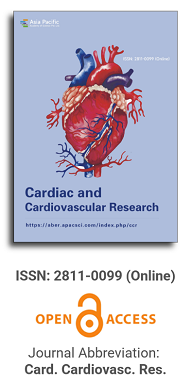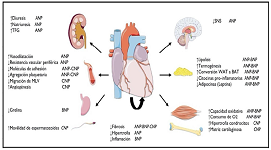
Asia Pacific Academy of Science Pte. Ltd. (APACSCI) specializes in international journal publishing. APACSCI adopts the open access publishing model and provides an important communication bridge for academic groups whose interest fields include engineering, technology, medicine, computer, mathematics, agriculture and forestry, and environment.

Current situation and research prospect of home monitoring technology for cardiovascular system
Vol 4, Issue 1, 2023
Download PDF
Abstract
Cardiovascular disease has become the leading cause of death in China. Home medical monitoring of cardiovascular circulatory system (cardiovascular system for short) is of great significance for the early detection, diagnosis and treatment of cardiovascular diseases. Physiological parameters of the cardiovascular system mainly include blood pressure, cardiac output, blood glucose content, blood oxygen saturation, ECG, respiration, etc. These physiological parameters need long-term daily monitoring to find the abnormalities and changes of the system. Therefore, home medical monitoring is necessary. This paper reviews the current situation of home monitoring technology for the main parameters of cardiovascular system in recent years, and prospects its future research trend.
Keywords
References
- Imai Y, Hozawa A, Ohkubo T, et al. Predictive values of automated blood pressure measurement: what can we learn from the Japanese population—the Ohasama study. Blood Pressure Monitoring. 2001; 6(6): 335-339. doi: 10.1097/00126097-200112000-00013
- Tanino Y, Shite J, Paredes OL, et al. Whole Body Bioimpedance Monitoring for Outpatient Chronic Heart Failure Follow up. Circulation Journal. 2009; 73(6): 1074-1079. doi: 10.1253/circj.cj-08-0847
- Yamakoshi KI. Unconstrained physiological monotoring in daily living for health care. Frontiers of Medical and Biological Engineering. 2000; 10(3): 239-259. doi: 10.1163/15685570052062710
- Pan F, Zheng DC, Murray A. Effect of stethoscope position on auscultatory blood pressure measurement. Computing incardiology, Zaragoza. 2013; 895-898.
- Nitzan M. Automatic noninvasive measurement of arterial blood pressure. IEEE Instrumentation & Measurement Magazine. 2011; 14(1): 32-37. doi: 10.1109/mim.2011.5704808
- Liu J, Hahn JO, Mukkamala R. Error Mechanisms of the Oscillometric Fixed-Ratio Blood Pressure Measurement Method. Annals of Biomedical Engineering. 2012; 41(3): 587-597. doi: 10.1007/s10439-012-0700-7
- Chen M, Wang Q, Mei Z, et al. A developed algorithm for oscillometric blood pressure measurement. 2013 IEEE International Conference of IEEE Region 10 (TENCON 2013). Published online October 2013. doi: 10.1109/tencon.2013.6718980
- Ando S. What does a perfect blood pressure meter look like from a clinician point of view? IEEE Instrumentation & Measurement Magazine. 2014; 17(3): 15-20. doi: 10.1109/mim.2014.6825383
- Pressman GL, Newgard PM. A Transducer for the Continuous External Measurement of Arterial Blood Pressure. IRE Transactions on Bio-Medical Electronics. 1963; 10(2): 73-81. doi: 10.1109/tbmel.1963.4322794
- Mackayrs RS, Marg E, Oechslir R. A quartz crystal tonometer. IRE Transactions on Bio-Medical Electronics. 1962; 9(2): 174-174. doi: 10.1109/tbmel.1962.4322986
- Gribbin B. Pulse wave velocity as a measure of pressure change. Psycho-physiology. 1976; 13(5): 87-90.
- Penaz J. Photoelectric measurement of blood pressure, volume and flow in the finger. Int.Conf.Med. Biol. Eng. 1973; 10: 104.
- Wesseling KH, Penaz J. Indirect blood pressure measurement in the finger; physiological background of a recent development. Scripta Medica. 1986; 59: 203-206.
- Yamakoshi KI, Shimazu H, Togawa T. Indirect Measurement of Instantaneous Arterial Blood Pressure in the Human Finger by the Vascular Unloading Technique. IEEE Transactions on Biomedical Engineering. 1980; 27(3): 150-155. doi: 10.1109/tbme.1980.326616
- Shimazu H, Fukuoka M, Ito H, et al. Noninvasive measurement of beat-to-beat vascular viscoelastic properties in human fingers and forearms. Medical & Biological Engineering & Computing. 1985; 23(1): 43-47. doi: 10.1007/bf02444026
- Steptoe A, Smulyan H, Gribbin B. Pulse Wave Velocity and Blood Pressure Change: Calibration and Applications. Psychophysiology. 1976; 13(5): 488-493. doi: 10.1111/j.1469-8986.1976.tb00866.x
- Lu W. Study on the main influencing factors of indirect measurement of blood pressure using pulse wave propagation velocity. Chinese Journal of Biomedical Engineering. 1995; 14(1): 8893.
- Xiang H, Yu M. Continuous measurement of blood pressure using pulse wave conduction time. Medical and health equipment. 2006; 27(2): 19-21.
- Li D, Chen Y, Xing L, et al. Non invasive continuous blood pressure detection system based on pulse wave velocity method. Aerospace Medicine and medical engineering. 2008; 21(5): 416-419.
- Tsui H, Zhou Q, Wei Y. Noninvasive blood pressure measurement. Journal of Chongqing Institute of technology. 2008; 22(1): 164-167.
- Tanaka S. A new ambulatory system for beat-to-beat blood pressure in superficial temporal artery using the volume-compensation method. Journal of the international federation for Med.& Bio, l Engineering. 1991; 29: 466.
- Nakagawara M, Yamakoshi K. A portable instrument for non-invasive monitoring of beat-by-beat cardiovascular hemodynamic parameters based on the volume-compensation and electrical admittance method. Medical & Biological Engineering & Computing. 2000; 38(1): 17-25. doi: 10.1007/bf02344683
- Song Y, Gao S, Wu L, et al. Development of small circulating dynamic monitoring system based on volume compensation method and electrical impedance method. Chinese Journal of medical devices. 2009; 33(3): 167-171.
- Tanaka S, Gao S, Nogawa M, et al. Noninvasive measurement of instantaneous radial artery blood pressure. IEEE Engineering in Medicine and Biology Magazine. 2005; 24(4): 32-37. doi: 10.1109/memb.2005.1463393
- Gao S, Song Y, Tanaka Z, et al. Wrist blood pressure continuous detection system based on volume compensation method. Chinese Journal of medical devices. 2009; 33(5): 323-327.
- Song Y, Gao S. Development of a new device for continuous detection of digital artery blood pressure based on local compression method. Journal of engineering of Heilongjiang University. 2010; 1(1): 104-109.
- Yoshizawainoi, Fujii K, Matsumura N, et al. Volume compensated continuous blood pressure measurement, pressurized vibration method, short time determination of control targets. Biomedical engineering. 2008; 46(2): 218-225.
- Lin Z, Huang Y, Yang W. Study on a new kubieck model of cardiac output per stroke. Journal of Xiamen University. 2008; 47(5): 677-680.
- Yan X, Gao S, Song Y. Methods and progress of cardiac output measurement. Journal of Biomedical Engineering. 2015; 32(3): 697-701.
- Hedelin P, Agger E, Ekmehag B, et al. Measurement of cardiac output with non-invasive Aesculon impedance versus thermodilution. Clin Physiol Funct Imaging. 2011; 31(1): 39-47.
- Ikarashi A, Nogawa M, Tanaka S, et al. Experimental and numerical study on optimal spot-electrodes arrays in transthoracic electrical impedance cardiography. In: Proceedings of the 29th IEEE EMBS Annual International Conference; 2007.
- Song Y, Gao S, Wu L, et al. Applicability of chest cylinder model in noninvasive cardiac output measurement with point electrode. Journal of Biomedical Engineering. 2013; 30(4): 12-19.
- Song Y, Gao S, Wu L, et al. Optimal electrode configuration for unconstrained cardiac output measurement based on electrical impedance method. Journal of Biomedical Engineering. 2011; 28(1): 32-35.
- Zhang L, Qi X, Jia X. Effect of hyperglycemia on short-term prognosis of elderly patients with acute heart failure. Chinese Journal of Gerontology. 2017; 37(23): 5827-5829.
- Yin Y, Hu A, Sun Q, et al. Analysis of risk factors for hypoglycemia in patients with diabetes. Clinical misdiagnosis and mistreatment. 2012; 25(2): 83-86.
- Liu Y. Study on noninvasive blood glucose detection based on the principle of reverse ion electroosmosis. Chongqing: Chongqing University of technology; 2013.
- Feng F. Analysis of symptom diversity in emergency patients with hypoglycemic reaction. Traffic medicine. 2018; 32(2): 168-169.
- Motoi K, Kubota S, Ikarashi A, et al. Development of a fully automated network system for long-term healthcare monitoring at home. In: Proceedings of the 29th IEEE EMBS Annual International Conference; 2007.
- Bandodkar AJ, Jia W, Yardımcı C, et al. Tattoo-Based Noninvasive Glucose Monitoring: A Proof-of-Concept Study. Analytical Chemistry. 2014; 87(1): 394-398. doi: 10.1021/ac504300n
- Motoi K, Ogawa M, Ueno H, et al. Development and clinical evaluation of a home healthcare system measuring in toilet, bathtub and bed without attachment of any biological sensors. In: Proceedings of the 10th IEEE International Conference; 2010.
- Qu L, Shi Y, Wang T, et al. Blood oxygen content monitoring system based on near-infrared light. Journal of natural science of Heilongjiang University. 2016; 33(3): 392-398.
- Ke Z, Yao G, Lin L. Introduction to blood oxygen saturation detection. China medical device information. 2004; 10(2): 34-36.
- Chen P, Xie H, Li H, et al. Monitoring cardiac output by CO2 partial re inhalation method. Journal of Suzhou University: Medical Edition. 2003; 23(4): 409-410.
- Cui J. Research and system development on simultaneous detection of blood pressure and oxygen saturation. Harbin: Heilongjiang University; 2014.
- Chen J, Cai Z, Liu R, et al. Clinical application value of portable ECG monitor in high-risk patients with atrial fibrillation. Journal of modern integrated traditional Chinese and Western medicine. 2018; 34: 3775-3777.
- Qu Y, An G, An Y, et al. Design of portable ECG monitor. Medical and health equipment. 2016; 37(4): 47-48.
Supporting Agencies
Copyright (c) 2023 Xiaowei Qu, Siyu Lu, Tong Zhang, Yilin Song

This work is licensed under a Creative Commons Attribution 4.0 International License.

This site is licensed under a Creative Commons Attribution 4.0 International License (CC BY 4.0).

Prof. Prakash Deedwania
University of California,
San Francisco, United States




